Smooth operation of the humidifier is ensured by sophisticated mechanisms and electronic programs. And like any other technique, these devices require proper handling and timely maintenance. But even if all operational requirements are met, the device may fail.
This article contains information on what are the most common humidifier errors and how to fix most of the problems yourself. Recommendations for the repair of steam, ultrasonic and traditional cold-type humidifiers are given. The material is supplemented with visual photos and thematic videos.
The content of the article:
- Signs of broken air humidifiers
-
Reasons for lack of steam and remedies
- Cold type apparatus
- Ultrasonic humidifiers
- Steam device breakdown
-
DIY step-by-step repair instructions
- Stage # 1 - disassembling the humidifier
- Stage # 2 - carrying out device diagnostics
- Stage # 3 - cleaning the structure
- Stage # 4 - Electronic Troubleshooting
- Stage # 5 - replacing the ultrasonic membrane
- Tips for using the device
- Conclusions and useful video on the topic
Signs of broken air humidifiers
Even during correct operation of the humidifier various problems may arise. So, users most often may be faced with the fact that no steam from a humidifier.
If this is an ultrasonic type device, then, in this case, first of all, you should make sure that the membrane is located under water. Another possible reason for such a breakdown is membrane clogging. For prevention purposes, you can wipe the part with a weak vinegar solution. The operability of the turbine and generator is also reflected in the steam flow.
Other popular problems encountered by humidifier owners include:
- The amount of water in the tank does not decrease in case of violation of the integrity of the membrane or the device responsible for its movement.
- Reduced or no air flow in operating mode due to clogged air intake filters and pipes. Equipment can also fail due to fan breakdown.
- In a room with a working device, the windows fog up, wet pollen appears on the furniture, and the sensor shows a normal value, this indicates a malfunction of the equipment. The optimum level of air humidity is no more than 60%.
- Steam has an unpleasant odor. The reason may be a clogged membrane, the spread of mold and mildew inside the device itself. You may also need to urgently replace filters.
- There is no sound signal, the timer is inactive, sensors. All this indicates a failure of the electronics. Also, the LCD screen will not work in this case.
- It's getting harder to breathe indoors when the device has exceeded the permissible humidity value. This means that the humidity sensor is not working.
- The humidifier continues to operate when the water level drops to the limit, although it should automatically shut down. This condition also applies to timer programming if the device continues to operate after the set time has elapsed. In this case, the equipment must be disconnected from the mains.
- Significant increase in case temperature indicates its overheating.
A breakdown in the electric motor or ventilation system is indicated by increased noise from the operation of the humidifier.
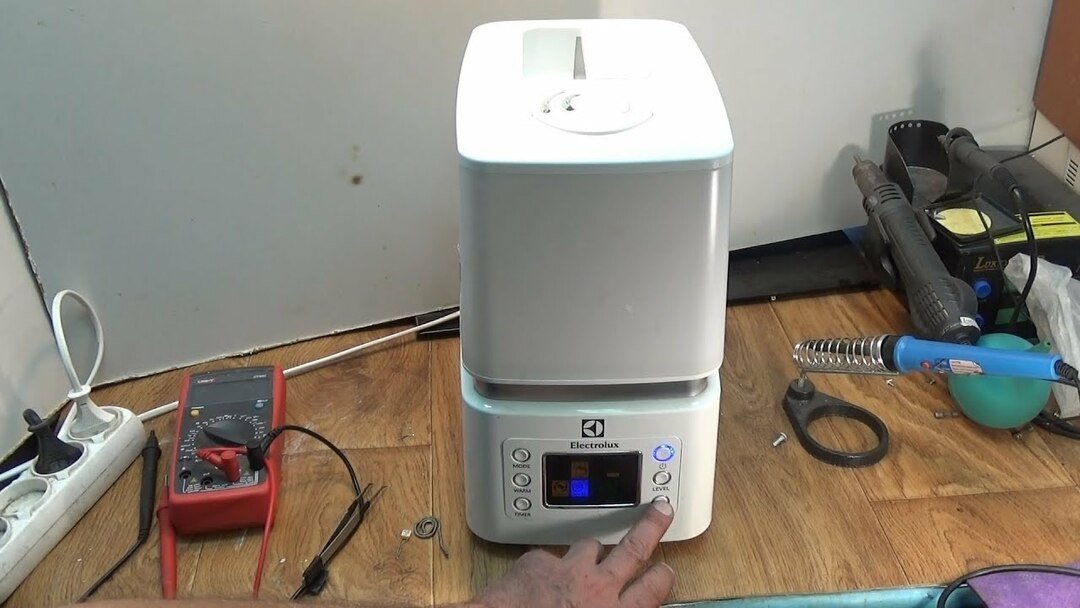
One of the main reasons for the breakdown of a humidifier is the ingress of moisture into the interior of the case when trying to pour water through the steam outlet
With the appearance of a characteristic singed smell disconnect the device from power immediately. The appearance of smoke - a sign of a serious malfunction of an electrical device, which must be disconnected from the mains immediately.
Reasons for lack of steam and remedies
Lack of steam is one of the most common malfunctions found in all types of humidifiers. Therefore, we will analyze in more detail the reasons for such a breakdown in each types of devices, and also talk about ways to eliminate it.
Diagnostics should start by checking the outlet, the indicator of the electrical device and the presence of water in the tank. But please note that any repair work is carried out only after disconnecting the humidifier from the mains.
Cold type apparatus
So-called traditional humidifiers can stop generating steam for several reasons:
- Filter wear - the parts should then be replaced with new ones.
- Engine malfunction. The unit is responsible for the operation of the turbine and fan. It cannot be repaired, the motor can only be replaced.
- Raid. If the sound of the engine is heard when the humidifier is turned on, and the turbine impeller and cooler remain stationary, the cause may be limescale, which should be removed. Breakage can also be determined by the direction of the steam, which will creep downward, and not come out vertically upward.
Lack of steam can also be provoked damaged wires, which often happens when transporting the device.
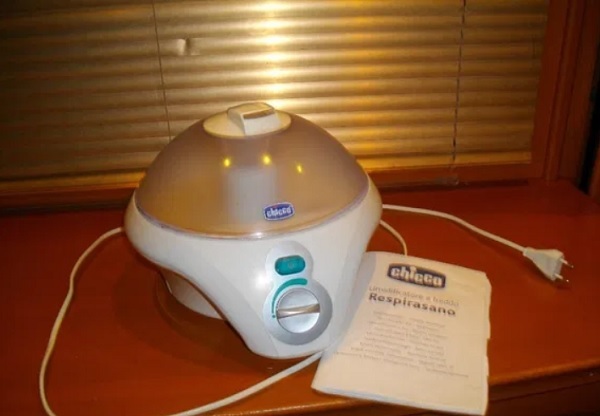
If the impeller does not move after turning on the device, disconnect the device from the mains and try to turn these elements yourself. If movement is difficult, then cleaning will be needed
Ultrasonic humidifiers
The key element of an ultrasonic humidifier is a membrane or disc (emitter, piezoelectric element) and a low-power fan. The membrane begins to vibrate when an alternating current is supplied with an ultrasound frequency, from which the water is broken into tiny particles, and the built-in fan pushes them into the room.
This type of humidifier often produces insufficient or no steam due to a malfunction of the electromechanical converter. It will not be possible to repair the breakage on your own; the part must be replaced. It is possible to establish the malfunction of the membrane by the absence of the characteristic sound of boiling water.
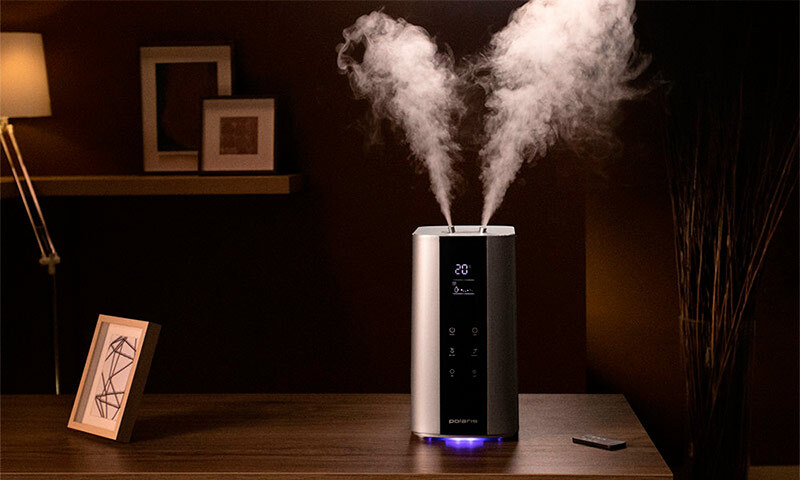
It is usually impossible to start a humidifier without water - the manufacturers have provided that the devices do not start the process of generating steam in the absence of a sufficient water level
If the humidifier was started up without water, then the membrane fails, and then the transistor. Prolonged operation in this mode can damage other elements of the generator board, which will lead to damage to the power supply.
Another reason for the malfunction of an ultrasonic type humidifier is contamination or damage to the membrane, as well as the failure of the mechanism that makes it vibrate (ultrasonic generation boards fluctuations). The problem can be eliminated by cleaning the membrane; it may also be necessary to replace the entire device that drives the converter.
It is also worth cleaning the membrane if too little steam is generated from the humidifier. This can be done with any descaling agent. Vinegar solution and citric acid will also help. The agent should be poured into the cavity with the membrane and wait until the scale dissolves completely. Too thick plaque can be removed with an old toothbrush. Using abrasive products or metal objects will damage the membrane.
Steam device breakdown
These humidifiers often do not generate steam due to a defective heating element. If the water does not heat up in the switched on device, you will need to replace the heating element.
Lack of steam can be due to impeller, motor, wiring and fan breakage, as is the case with cold-type devices.
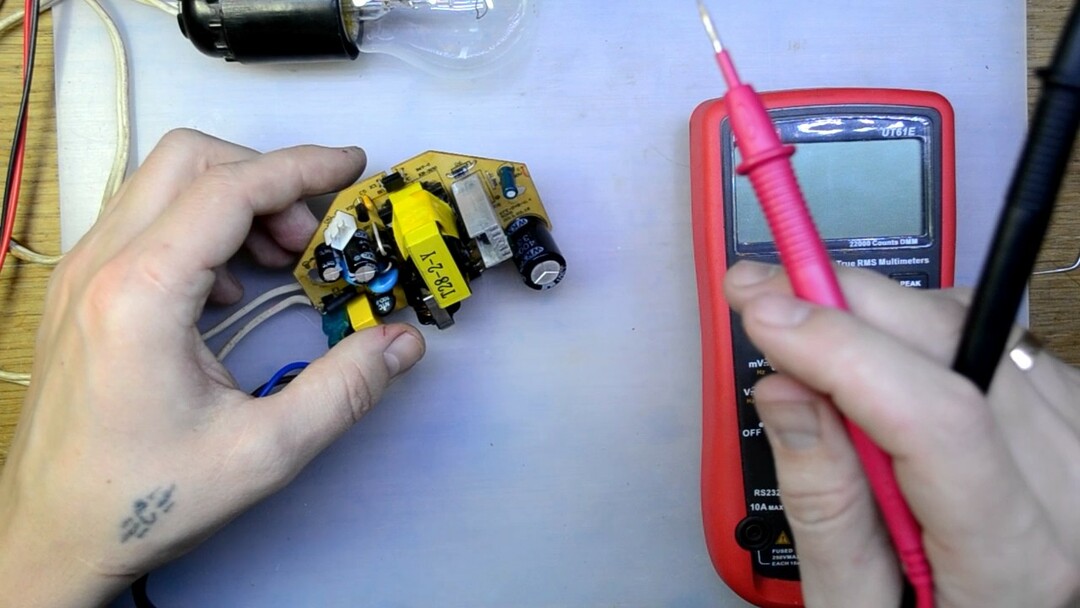
If the hygrometer reading does not change during the first days of using the humidifier, the reason may be excessive dryness in the room air. You should wait about 5-10 days until all interior items absorb moisture
There is one more type of air humidifiers - spray, but its repair should be carried out exclusively by specialists. Interference with an expensive device can be harmful.
DIY step-by-step repair instructions
You can descale the membrane and other parts, and replace the filters yourself. It is better to entrust the repair of nodes, including the motherboard, to professionals. Interference with the structure can complicate the situation.
To carry out repairs at home, you will need basic knowledge of an electrician, a multimeter, a tester, and soldering skills.
Next, we will consider step by step the process of repairing an ultrasonic-type household air humidifier.
Stage # 1 - disassembling the humidifier
To find out the cause of the breakdown, it is necessary to disassemble the device, having previously de-energized it.
Before removing the tank, prepare a special fluid bowl. Remaining moisture in the pallet can be removed with a dry cloth. Bolts are placed under the rest of the body - from 3 to 5 pieces. By unscrewing them, you can remove the bottom cover.
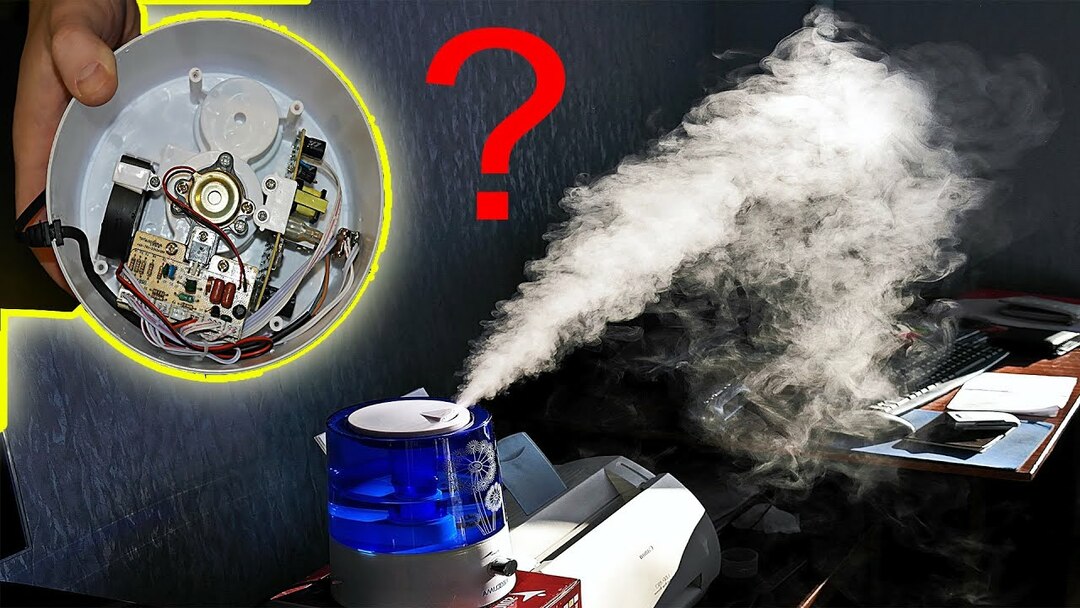
After disassembling the air humidifier, it is advisable to photograph the initial position of all parts, which will help to assemble the device in the reverse order.
If the humidifier has a built-in hygrometer, it is important to avoid sudden movements as this could damage the contacts and wires of the device. As a rule, it is attached near the ventilation grill - on the inside of the bottom cover.
Stage # 2 - carrying out device diagnostics
With the device disassembled, a few simple tests can be carried out to rule out possible breakdowns. To do this, connect the humidifier to the network and check the operation of the cooler or fan.
After two minutes of operation and after unplugging from the socket, the temperature of the transistor can be felt by touch. If it is cold, then this indicates a malfunction of the generator.
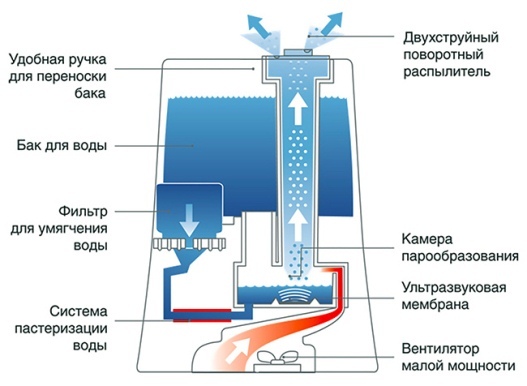
Diagram of an ultrasonic humidifier. The main elements are a spray, an ultrasonic membrane, and a fan. Some models can also be equipped with hygrometers, filtration system, additional sensors
A breakdown of the radiator can be determined by the absence of sounds from the membrane, in this case the part must be replaced. It remains to ring all the contacts on the board using a multimeter.
If all of the above malfunctions are not confirmed, the reason for the inoperative air humidifier may be a trivial blockage of the cartridge. This can be avoided by timely replacement of filters.
Stage # 3 - cleaning the structure
In addition to changing filters, maintenance also includes rinsing the container under running water and wiping the inside out with a soft brush or cloth.
Do not use harsh chemicals such as dishwashing liquid or toilet cleaning gels. Not only the parts of the humidifier, but all households may suffer. After all, the remaining particles of the substance on the walls will get into the air during the next start of the device.
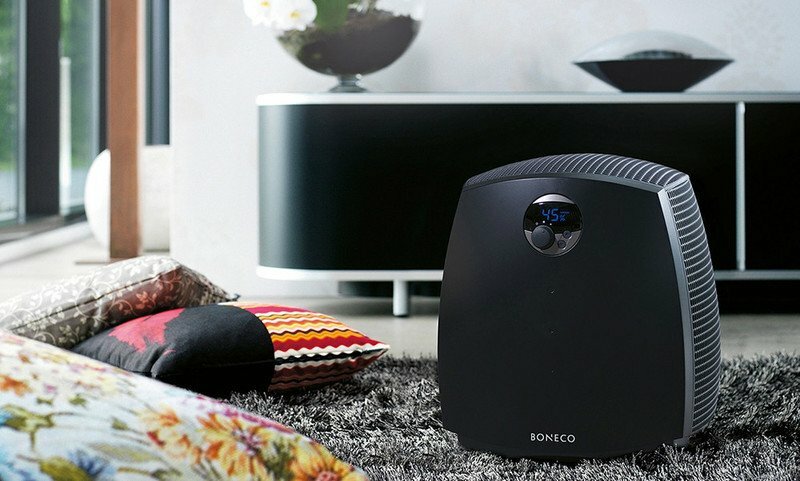
Ultrasonic humidifiers are one of the most efficient and safest devices. The principle of their operation is based on the vibration of the plate, the rapid vibrations of which knock out small particles from the surface of the water.
Safe use of a humidifier also involves disinfection; this is no longer a regular cleaning, but getting rid of accumulated microorganisms. For this purpose, acetic acid, chlorine bleach and hydrogen peroxide are used.
The latter substance is used in pure form. The bleach is diluted with water and the acid is adjusted to a concentration of 10 to 20%. The resulting mixture is poured into a container and kept for several hours. After the procedure, it is important to thoroughly rinse the humidifier and wipe it with a soft cloth.
We have provided detailed recommendations and the best ways to clean humidifiers in this article.
Stage # 4 - Electronic Troubleshooting
It is possible to determine the presence of a breakdown of the board even by visual inspection.
If it is in good working order, then it should have the following properties:
- evenly colored;
- there are no smudges and stains on the surface;
- without exception, all contacts are soldered and ringed;
- there are no swollen elements;
- no darkened resistors (a change in shade indicates the combustion of the part).
It is also important to check for breakouts in the board tracks.

The board must be cleaned of white bloom. It is advisable to use alcohol for this purpose, and cover the top with an additional layer of varnish. This method will increase the reliability of the part and protect against short circuits.
A short circuit can damage the fuses and require soldering. To remove the card from the slot, unscrew the screws and then clean the surface with a soft brush and alcohol.
Stage # 5 - replacing the ultrasonic membrane
How to determine the malfunction of the membrane, we discussed above.
The process of replacing it includes several stages:
- it is necessary to unscrew the fastening bolts;
- then remove the ceramic ring with part of the board;
- a round membrane is attached to the board with a pair of wires, which should be carefully evaporated;
- completes the process of soldering the wires of the new piezoelectric element into the board.
When replacing the membrane, it is advisable to immediately replace the high-frequency transistor by choosing a spare part that meets the factory requirements. Discrepancies in characteristics can make it difficult for steam to form.
Tips for using the device
The following tips will help protect your humidifier from damage:
- Water must be poured directly into the opening provided for this purpose by the manufacturer.
- It is forbidden to use a steam nozzle for inhalation; some models have a special nozzle for this purpose.
- Vinegar should be used for cleaning equipment only in the fresh air, otherwise it may burn the mucous membrane of the respiratory tract.
- It is not recommended to place the device near electrical devices.
- Before disconnecting the humidifier from the mains, do not disassemble it and touch the internal parts with your hands.
- Do not touch the humidifier housing with wet hands.
- Damaged elements should be disposed of in the manner stated by the manufacturer in the safety regulations.
It is also important to remember that during operation, the device must not be covered from above; there must be oxygen access in the lower part, where air is directly drawn.
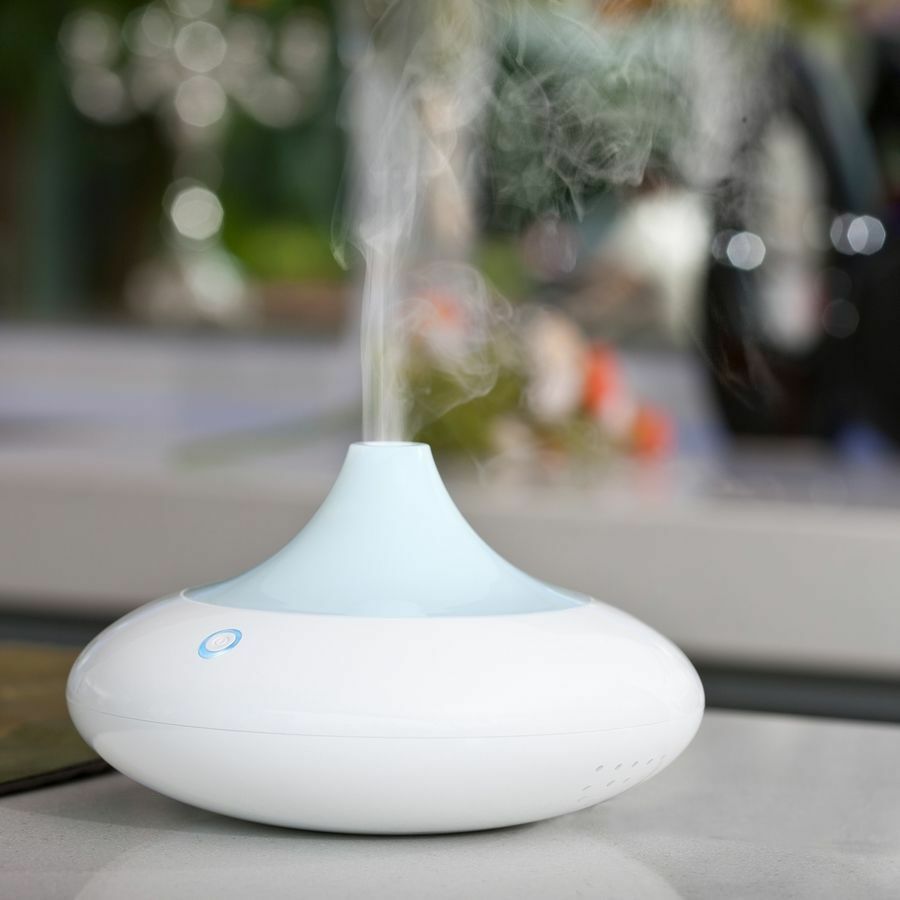
Scale is caused by the use of inadequate water quality. Manufacturers recommend pouring distilled water into air humidifiers, as scale can cause the device to leak.
A few simple guidelines will also help extend the life of your humidifier:
- If the device does not have a built-in filter, it is advisable to use boiled, distilled or pre-filtered water. About what kind of water to fill in the humidifier, we are in detail told here.
- It is advisable to disinfect the component parts with a vinegar solution twice a month. The water should be changed daily to help prevent mold.
- Modern models are equipped with a function of notification about the need to clean and replace filters. Replacement parts must be of the same brand name as the device itself. We recommend that you familiarize yourself with rating of the best models.
- Install the humidifier on a perfectly level surface. Free air access is also important for smooth operation. It is not recommended to lean the equipment against a wall, leave it near furniture or under a bed.
- It is forbidden to leave the device in a room with small children unattended. There are cases when the humidifier was pushed or covered with a blanket on top, and small parts also fell into the air intake slots.
If the equipment is used only during the heating season, then before sending it for storage, it is necessary to treat the tubes and membranes with hydrogen peroxide. Then disassemble and dry all the details. Keep in original sealed container out of direct sunlight.
Do not add essential oils to a non-aromatherapy humidifier. Otherwise, components can quickly fail.
Conclusions and useful video on the topic
The solution to the problem of lack of steam in the air humidifier is discussed in detail in the plot:
Step-by-step instructions for checking piezoelectric elements for humidifiers can be viewed in the following video:
How to fix an ultrasonic humidifier at home:
In most cases, you can repair your humidifier yourself. It is much more difficult to find the real cause of the malfunction. It is quite difficult to do this in some situations without special devices, so it is better to turn to specialists. Proper operation of equipment, timely replacement of filters, cleaning and disinfection will help to avoid serious breakdowns.
If you have encountered problems with the operation of a humidifier, share your experience. The block for comments and questions is below the text - here you can ask questions to our experts and other users about the poor performance of the device and possible breakdowns.


